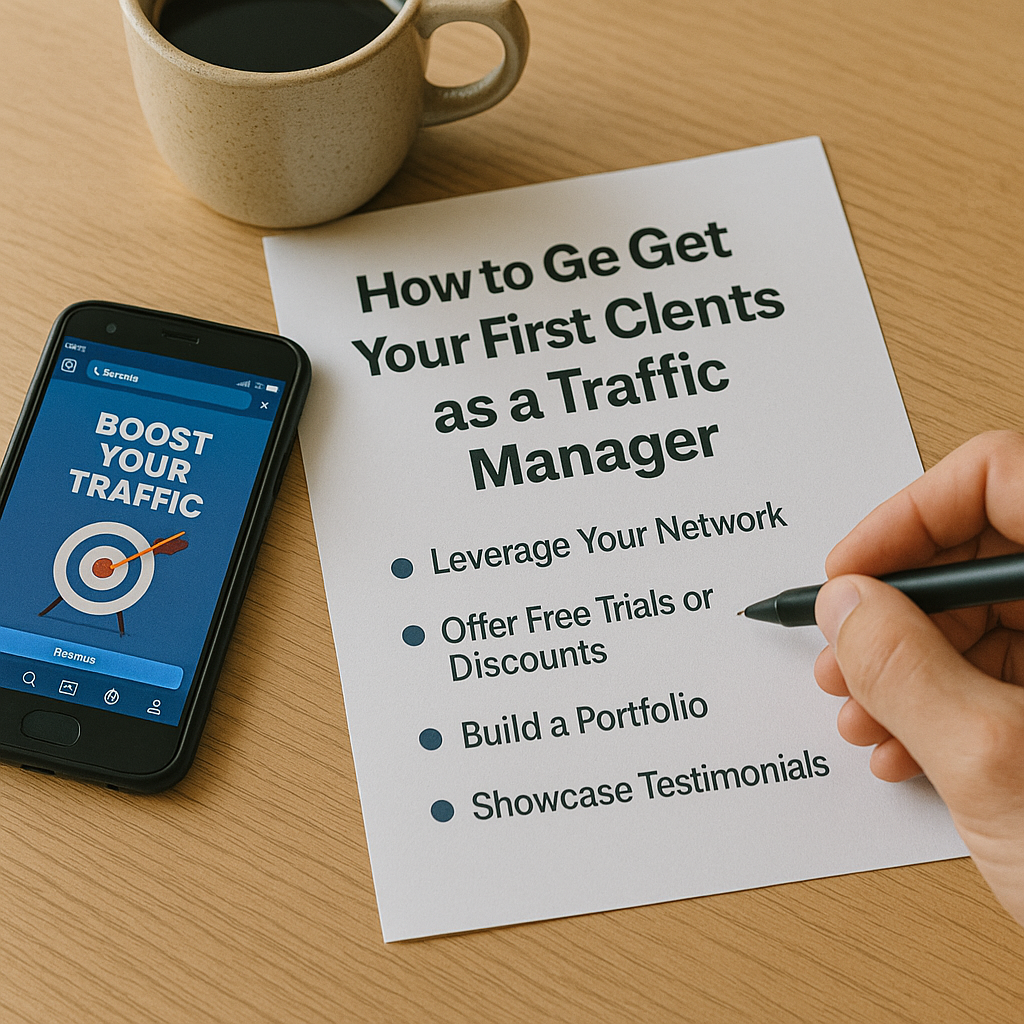Becoming a traffic manager is one thing—getting your first paying clients is another. Many aspiring professionals build solid knowledge in Meta Ads, Google Ads, or TikTok campaigns but struggle when it comes time to turn those skills into real income.
In this article, you’ll learn how to get your first clients as a traffic manager, even if you have no portfolio or professional experience yet. These steps work whether you want to freelance, join an agency, or build your own business.
1. Define the Type of Client You Want to Work With
Before looking for clients, define your ideal client profile. Are you targeting:
- Local businesses (gyms, restaurants, dentists)?
- E-commerce brands?
- Coaches or digital product creators?
- Agencies looking for media buying support?
Being clear about your niche will help you focus your messaging and approach. It’s better to specialize at first than to try to serve everyone.
2. Build a Simple Portfolio, Even Without Clients
You don’t need big brand names to build a portfolio. You can create one by:
- Running small campaigns for your own product, blog, or affiliate offer
- Creating mock campaigns for fictional businesses
- Offering a free or discounted test campaign for a real business
- Documenting your knowledge and processes (e.g., screenshots of campaign setups, ads you’ve created, results you’ve simulated)
Even a 3-page PDF or Notion page with well-organized screenshots and explanations builds credibility.
3. Offer Free or Discounted Campaigns to Get Testimonials
If you’re just starting out, one of the fastest ways to build trust is to run one or two campaigns for free or at a very low cost. In return, ask for:
- A testimonial
- Permission to use the results in your portfolio
- A referral if the client is happy
This small gesture gives you real experience, confidence, and material to present to future paying clients.
4. Leverage Your Personal Network
Don’t underestimate the power of friends, family, and local connections. Let people know:
- You’re launching your career as a traffic manager
- You can help businesses grow with online ads
- You’re available to run a free or trial campaign
Even someone with a small shop, service, or personal project could become your first client—or introduce you to one.
Use your Instagram, WhatsApp, LinkedIn, and Facebook to share what you do. Many professionals get their first clients from people they already know.
5. Reach Out to Local Businesses Directly
Walk into local stores or services and offer help. Most small business owners:
- Know they need online marketing
- Have tried boosting posts or running simple ads
- Don’t have time or expertise to manage it well
You can offer to:
- Audit their current social media ads
- Set up a simple Meta or Google campaign
- Track results for 7–14 days and report back
Keep it simple and speak in non-technical language. Focus on the benefits: more calls, more bookings, more visibility.
6. Use Freelance Platforms
Online marketplaces can also be a good place to start. You can find clients on:
- Upwork
- Fiverr
- Workana
- PeoplePerHour
- Freelancer.com
Tips to stand out:
- Write a personalized proposal for each job
- Offer a competitive price for your first few projects
- Show proof of skills (certifications, test campaigns, screenshots)
- Keep your profile clear and professional
Once you complete 1–2 jobs and get positive reviews, it becomes easier to attract more clients.
7. Offer Campaign Setup as a One-Time Service
If monthly retainers feel too big to pitch, offer one-time services like:
- Campaign setup for Facebook or Google Ads
- Pixel installation and tracking setup
- Keyword research and Google Ads account structuring
- Retargeting campaign creation
These “quick wins” are easier to sell and can lead to long-term contracts if the client sees value.
8. Create Educational Content to Build Trust
Start sharing what you know on social media—even with a small audience. Post tips like:
- “How to get more customers with Instagram Ads”
- “3 mistakes most businesses make in Google Ads”
- “Why boosting posts isn’t enough to grow your brand”
You’ll position yourself as someone who understands traffic management, which builds trust and authority.
9. Use Cold Outreach (The Smart Way)
Cold messages can work—if they’re well written. Instead of spammy emails, send personalized DMs or emails to business owners showing:
- You understand their business
- You’ve reviewed their ads (or lack of them)
- You can help increase their results
Example:
“Hi Sarah, I saw your bakery on Instagram and noticed you’re not running any local ads. I’m a digital traffic specialist and would love to offer you a free 5-day ad campaign to bring more people into your store. Can we talk this week?”
Always focus on the benefit and value—not on your lack of experience.
10. Ask for Referrals
After every successful campaign—especially your first few—ask for referrals. Something simple like:
“Do you know another business owner who could use help with online ads? I’m looking to take on one or two more clients this month.”
Referrals often turn into your best long-term clients.
Bonus: Get Certified to Add Credibility
Having official certifications can help you gain trust, even as a beginner. Start with:
- Meta Certified Digital Marketing Associate
- Google Ads Search Certification
- TikTok Ads Academy
- HubSpot Inbound Marketing Certification (optional)
Add these to your email signature, profile bio, and proposals to show that you’re serious and skilled.
Final Thoughts: Start Small, Stay Consistent
Your first client might not be a big brand—and that’s okay. What matters is that you:
- Deliver results
- Communicate clearly
- Build relationships
- Learn with every campaign
As your experience grows, so will your confidence—and your pricing. Many successful traffic managers started with a free campaign and turned that into a full-time career.
Don’t wait until you “feel ready.” Start offering value today, and the clients will follow.

